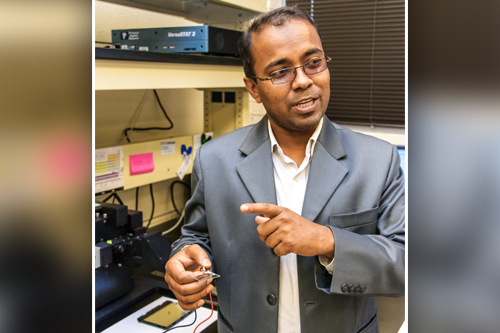
Jasim Uddin explains how organic carbon-based 3-D flexible cells absorb photon radiation to produce electrical energy. Uddin’s research team is the first in the world to produce extremely high energy efficiency in this kind of material. MARIO GONZALEZ/THE RIDER
A University of Texas Rio Grande Valley research team is the first in the world to produce extremely high energy efficiency using organic carbon-based 3-D flexible cells, according to preliminary results.
“We are producing radiation from [a solar simulator],” Jasim Uddin, principal investigator and visiting associate professor, said during a tour of the Brownsville campus lab Nov. 9. “It has [ultraviolet light], it has [infrared radiation], it has other radiation. It is exposing to the cell. The cell is sensing and converting from photon to current … from light to electrical energy.”
Justin Moore, co-principal investigator and Chemistry Department chair, said the difficult part was converting sunlight into electrical energy. He said a lot of efficiencies they have seen previously are between 5 percent and 7 percent for organic carbon-based 3-D flexible cells.
“Just on early results, it looks like we might be somewhere in 10, 15 percent, maybe more,” Moore said. “So, we might be tripling what or doubling what’s already out there right now, for this type of device.”
Besides breaking ground using the flexible cells, the research team received a $125,000 grant two weeks ago from the U.S. Defense Department to create a “smart uniform” prototype.
Made of nanostructured photoactive thin film, the uniform would self-clean, be anti-microbial and have protective properties against radiation exposure.
Uddin said preliminary tests indicate that the cloth has self-cleaned and protects the body from bacteria within 30 minutes after being exposed to sunlight. Bacteria or grease stains are eliminated from the cloth using sunlight and are oxidized into carbon dioxide and water.
“So, our personnel who is wearing this textile is safe, but it needs a little light,” Uddin said about the uniform. “Our defense team is working outside most of the time, and that is why they need smart clothes. So, they will be safe from any microbial and any staining and any other hazardous radiation purpose too.”
Uddin said the clothing will absorb the radiation, protect the body and, in turn, let the person wearing the suit know that there may be high levels of radiation. Personnel wearing the uniform will be able to harness radiation absorbed in the suit and transform it into energy using the organic carbon-based 3-D flexible cells.
Uddin said the university will patent its research, so companies may be able to use it for their products, creating revenue for the institution.
Some practical applications include using the suit as a heater in cold temperatures, or charging a cell phone as in a sunny day.
Taking its research to the next level, Uddin and Moore’s team plans to expand on the flexible cells to create an artificial nervous system that would administer the status of a structure in real time.
“Instead of having wires, the whole thing just becomes a conductive surface. The whole body becomes a sensor, a feedback system,” said Glenn Grissom, a graduate physics student. “If we can develop the software, then we can feed it into the system and we can sense everywhere exactly what’s happening out in that system. How much it’s flexing, how hot it is, how much expansion is going. Is there anything impacting the surface? What kind of radiation is falling on the surface? Are we being detected by a radar? Is somebody looking at us? We can tell.”
The team will use the grant to hire two graduate and three undergraduate students for a year. The grant can be renewed an additional two years, opening the door for more people to come on board.
“I believe that students who will be working with us, their future will be bright because, you know, this is the smart age, this is the nanotechnology age,” Uddin said. “We need smart [students] who would be working in smart research
work, they would definitely have a bright future, for their future career, that’s what we believe.”
For more information, call Uddin at 882-7772 or Moore at 882-5737.






